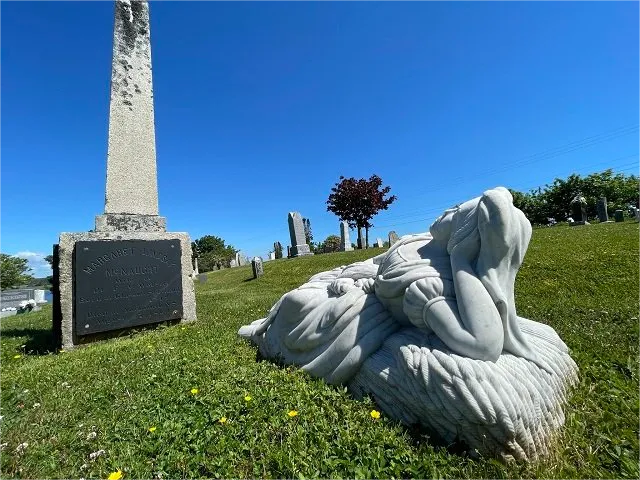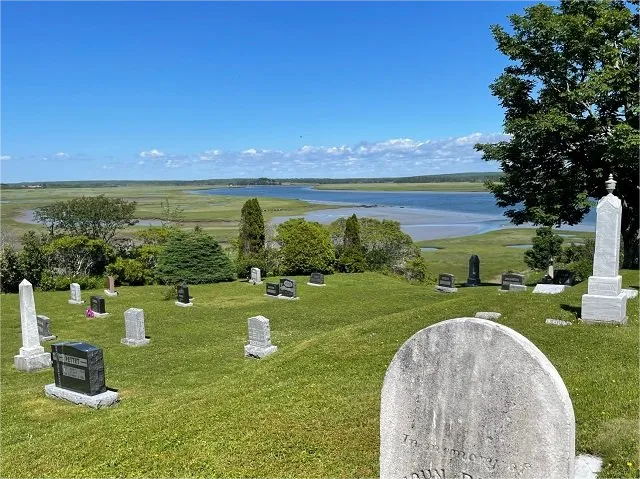The Marble Lady of Yarmouth – Nova Scotia Art Treasure
- by Mohamed Adam

Who is the Marble Lady?
Resting in the glorious Canadian Maritime sunshine, she glistens as if recently polished by a dental hygienist. While nearby tombstones sit dull and grey from coastal weather, the lady of marble lies pristine.

Margaret Lindsay McNaught Webster, born in Glasgow, Scotland in 1819 is the inspiration behind the marble art in this Nova Scotia cemetery. Commissioned by her husband Dr. Frederick Augustus Webster after her death in 1864, the marble figure is an unusual sight in the modest graveyard.
Does the marble figure resemble Mrs. Webster?
Locals in Yarmouth tell of Dr. Webster studying medicine at the University of Glasgow, Scotland. One day he glimpses his future bride, lying in a field with sunshine cascading over her beauty.
Immediately smitten, the good doctor sweeps Margaret off her feet. A love-at-first-sight romance blossoms for the native Nova Scotian and his Scottish sweetheart. Married at the McNaught’s lavish home, the couple sail to Canada and began their lives together in Yarmouth.
A popular story is that following Margaret’s untimely death from an unknown illness, the commemorative Marble Lady is sculpted, in likeness of Dr. Webster’s bride in the Scottish field. Sketching a portrait of his wife for memorial carver S.F. Raymond, Dr. Webster awaited the small model carving of his lost love.
Once complete, and with the approval of the grieving doctor, a life-size marble carving of the beautiful Margaret Webster was created.
A less romantic, and widely accepted explanation, also exists. In this version of the origin of the marble effigy, heartbroken Dr. Webster also commissions the sculpture. However, in this instance, the sculptor uses the figure of a woman on a matchbox to create the carving.
For a century and a half the Marble Lady of Yarmouth continues to rest peacefully in Chebogue. Whether she actually looks like Margaret or a matchbox figure depends on whom you ask in Yarmouth.
History of the Chebogue Cemetery at Town Point
The 12 minute drive from Yarmouth takes visitors to the location where the first English speaking settlers arrived on June 9, 1761. Overlooking the Chebogue River, the sloping green land of the cemetery has been providing eternal resting spots since 1766.

The Miꞌkmaq gave the name Chebogue, meaning big marshes, as the area has a large expanse of salt marshland along the river. Miꞌkmaq stone tools dating 5000 to 7000 years have been found nearby.
The first European discovery of Chebogue was in 1607 as indicated by Samuel de Champlain’s map showing buildings along a river, most likely the Chebogue River. This would place Chebogue as the second oldest European settlement in Canada, after Port Royal, Nova Scotia (1605).
A permanent Acadian settlement was established at Chebogue in 1614. This settlement was also referred to as Port Lomeron. An Acadian presence remained here until 1758 when the settlement was destroyed, and the Acadian population deported.
In 1761, English settlers, called Planters, arrived from New England and settled in the Chebogue. The Planters came to this area by invitation to settle vacant lands recently vacated by expulsion of the Acadians.
Town Point refers to the prominence of land where the non denominational cemetery is located. Stone walls and two iron gates line the side adjacent to the ground. Grass covered walkways allow visitors to easily access all areas of the municipal heritage site.
Where to find the Marble Lady of Yarmouth
The statue lies within Chebogue cemetery, often referred to as Town Point cemetery. Google maps prefers the first label.
Leaving Yarmouth via Main Street, changing in name to Chebogue Road.
At Wyman Road turn left for 3.7 kilometres.
Turn right at Chebogue Road for 1.7 kilometres.
Turn left onto Town Point Road. After 400 metres park at the gravel pullout by the last gate of the cemetery.
Walk about 20 metres into the cemetery through the last gate. The marble lady is located about another 20 metres to the left.
Who is the Marble Lady? Resting in the glorious Canadian Maritime sunshine, she glistens as if recently polished by a dental hygienist. While nearby tombstones sit dull and grey from coastal weather, the lady of marble lies pristine. Margaret Lindsay McNaught Webster, born in Glasgow, Scotland in 1819 is the inspiration behind the marble art…




